Key takeaways
- Wedding photography combines art and emotion, focusing on capturing genuine moments using natural light and effective composition.
- Adobe Lightroom and Photoshop are essential tools for editing, allowing for color correction and intricate adjustments to enhance photographs.
- Common editing techniques include non-destructive adjustments, color correction, and sharpening for impactful storytelling through images.
- Clear communication with clients about preferences and expectations is vital for delivering personalized and satisfying results.
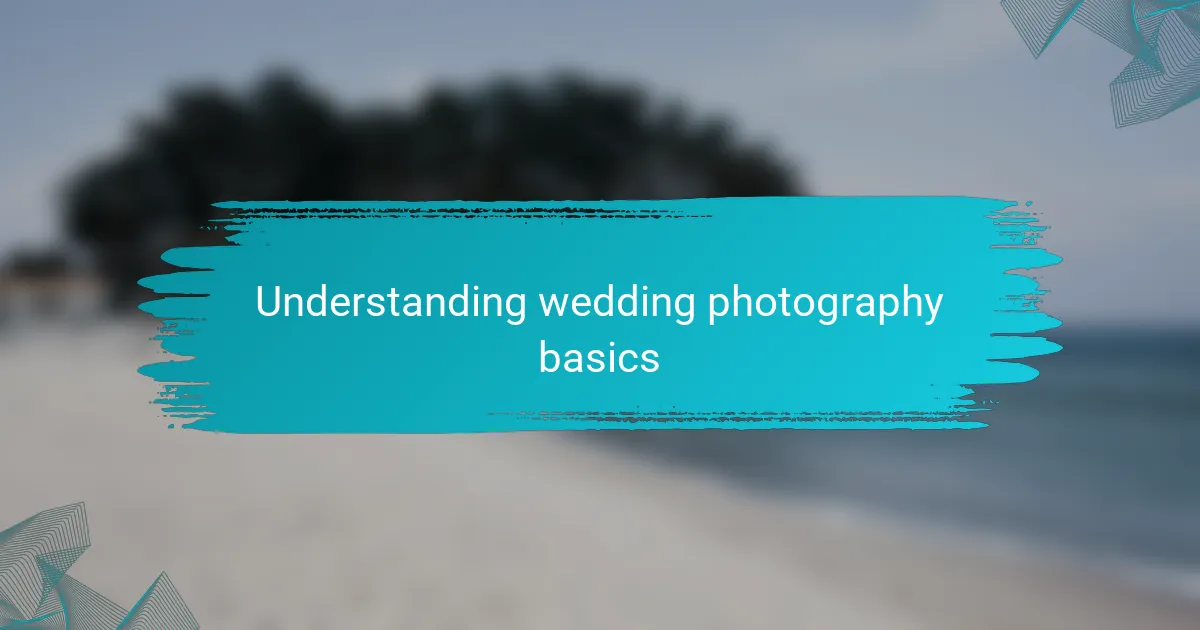
Understanding wedding photography basics
Wedding photography is a beautiful blend of art and memoir, capturing fleeting moments that tell a couple’s unique love story. I remember my first wedding shoot, feeling overwhelmed yet exhilarated by the atmosphere of joy and celebration. Each snap I took wasn’t just a task; it was a chance to frame a moment of happiness forever.
Understanding the basics of wedding photography involves knowing how to manage lighting and composition effectively. I’ve learned that using natural light can create soft, enchanting images, while good composition helps to guide the viewer’s eye through the story of the day. Lessons from experience tell me that every wedding has its own rhythm, and being adaptable is key to capturing those candid, memorable moments.
| Aspect | Details |
|---|---|
| Lighting | Use natural light for soft images; consider flash for indoor venues. |
| Composition | Focus on framing the couple and significant moments; rule of thirds can enhance shots. |
| Emotion | Capture candid smiles, tears, and laughter for genuine storytelling. |
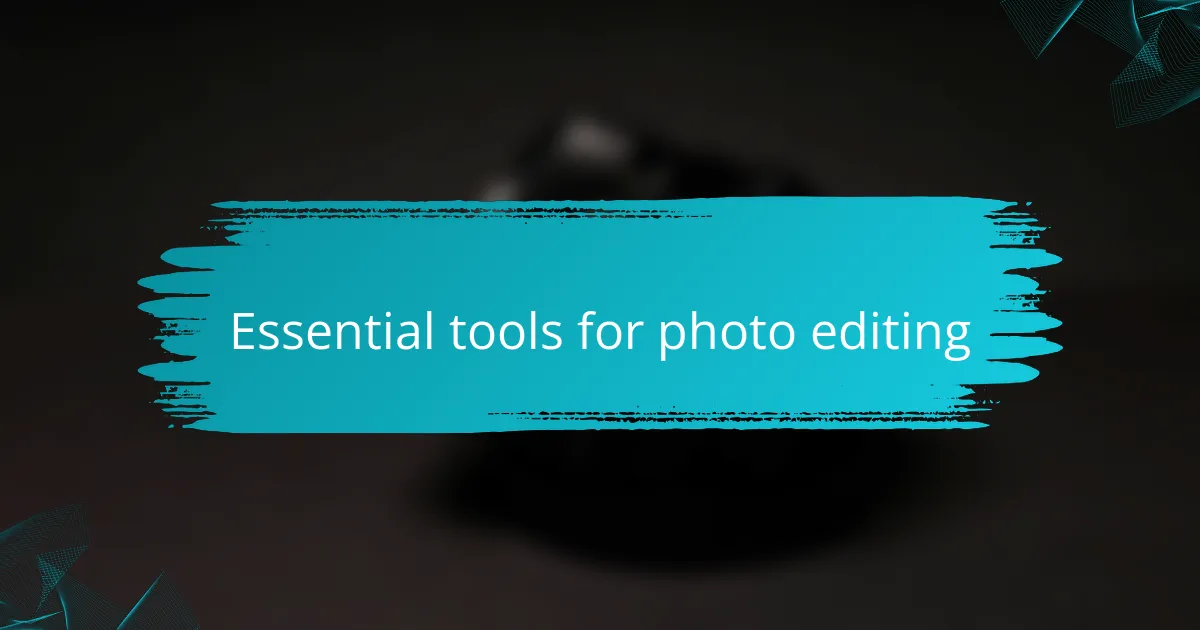
Essential tools for photo editing
When it comes to photo editing, having the right tools is essential for transforming raw images into stunning pieces of art. I rely heavily on Adobe Lightroom for its powerful color correction and exposure adjustments, which help bring out the emotion behind each shot. How many times have you taken a photo that felt a bit flat but just needed that pop of color? Lightroom can work wonders in those situations.
Photoshop, on the other hand, is my go-to for more intricate edits. I often find myself using the healing brush tool to remove distractions or imperfections, ensuring that the focus remains on what truly matters—the couple and their love. It’s fascinating how these small adjustments can create a significant impact. Have you ever spent hours on a photo only to step back and realize how much better it looked after a few tweaks?
In addition to Lightroom and Photoshop, I can’t overlook the importance of plugins and presets. They can streamline my workflow and add unique touches, saving valuable time without compromising quality. I remember when I first discovered presets; they became a game-changer for my editing speed. It’s like having a personal assistant who understands my style and helps carry the load.
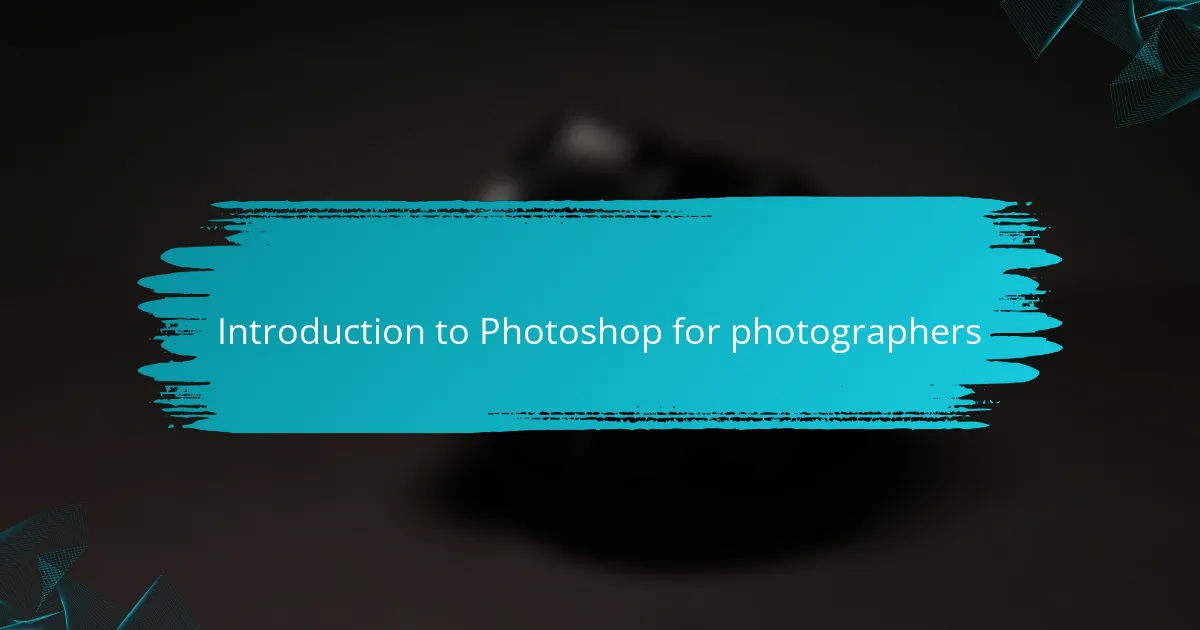
Introduction to Photoshop for photographers
When I first ventured into the world of wedding photography, I quickly realized that capturing the perfect moment was just the beginning. Editing with Photoshop became a crucial part of my workflow. It not only allowed me to enhance the beauty of each image but also helped me to tell a more compelling story through my clients’ photographs.
Photoshop’s vast array of tools can feel overwhelming at first, but with practice, it becomes an indispensable ally. I remember feeling a mix of excitement and trepidation as I learned to navigate its features. Each edit taught me something new about my style and how to bring out the emotions in my photos, creating images that my clients cherish.
Here’s a brief comparison of some key features and their applications for photographers:
| Feature | Application |
|---|---|
| Layers | Allows for non-destructive editing, enabling adjustments without losing original images. |
| Adjustment Tools | Helps in fine-tuning colors, brightness, and contrast for a polished look. |
| Retouching | Facilitates removing blemishes or distractions, enhancing the overall composition. |
| Filters and Effects | Adds creative flair or mood adjustments to match the wedding’s ambiance. |
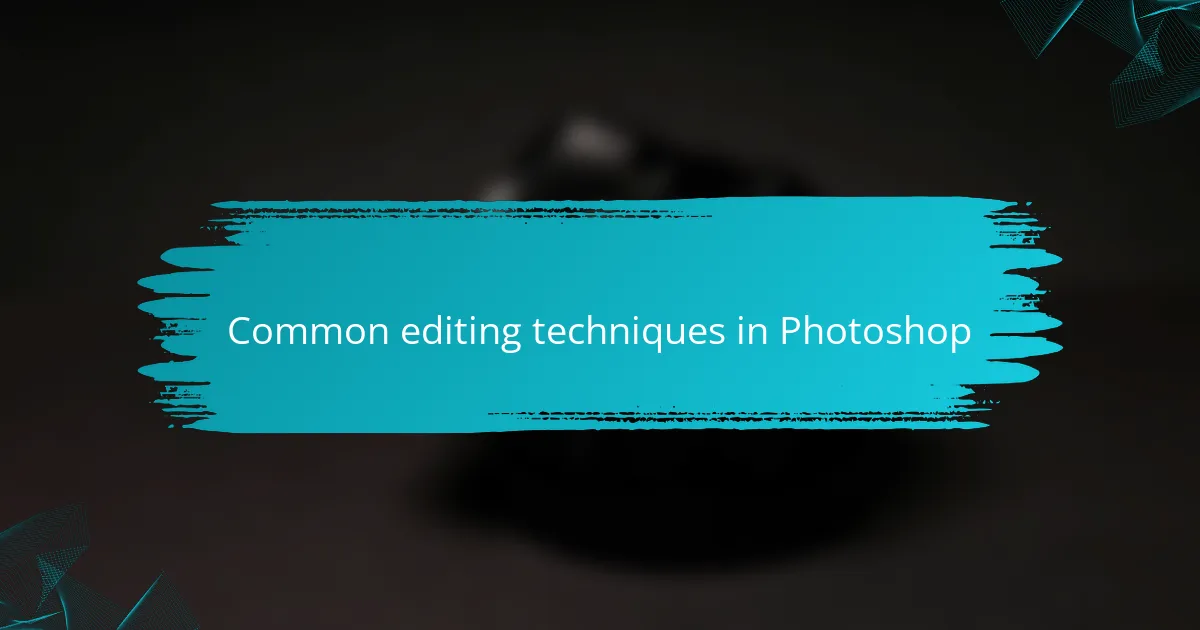
Common editing techniques in Photoshop
When it comes to editing wedding photos in Photoshop, I find that a few common techniques can elevate the images significantly. One of my favorite approaches is using the Adjustment Layers, which allows for non-destructive edits. This means I can tweak colors or brightness without permanently altering the original photo, giving me the freedom to experiment until I achieve the desired look. Additionally, I often use the Clone Stamp Tool for scrubbing away minor distractions, like the random stray hair or a wayward object in the background—these small tweaks can really make a difference in the final presentation.
Another editing staple for me is color correction, which helps in ensuring that the vibrancy of the wedding day shines through. I often rely on the Curves adjustment for this purpose, fine-tuning the brightness and contrast to match the mood of the moment captured. For instance, a soft, romantic tone might benefit from warmer colors, while a vibrant outdoor wedding could shine with brighter hues.
Lastly, I can’t overlook the importance of sharpening the images. After all the editing, applying a subtle sharpening helps define details in the couple’s expressions or the delicate lace of a wedding gown, enhancing the overall impact of the photograph. Each of these techniques contributes to storytelling through imagery, ensuring that the emotions of the day are powerfully conveyed.
| Technique | Description |
|---|---|
| Adjustment Layers | Allows for non-destructive editing, enabling flexibility in color and brightness adjustments. |
| Color Correction | Ensures the colors are true to life, matching the mood and lighting of the wedding day. |
| Sharpening | Enhances details, giving clarity to expressions and textures, and increasing the overall impact of the image. |
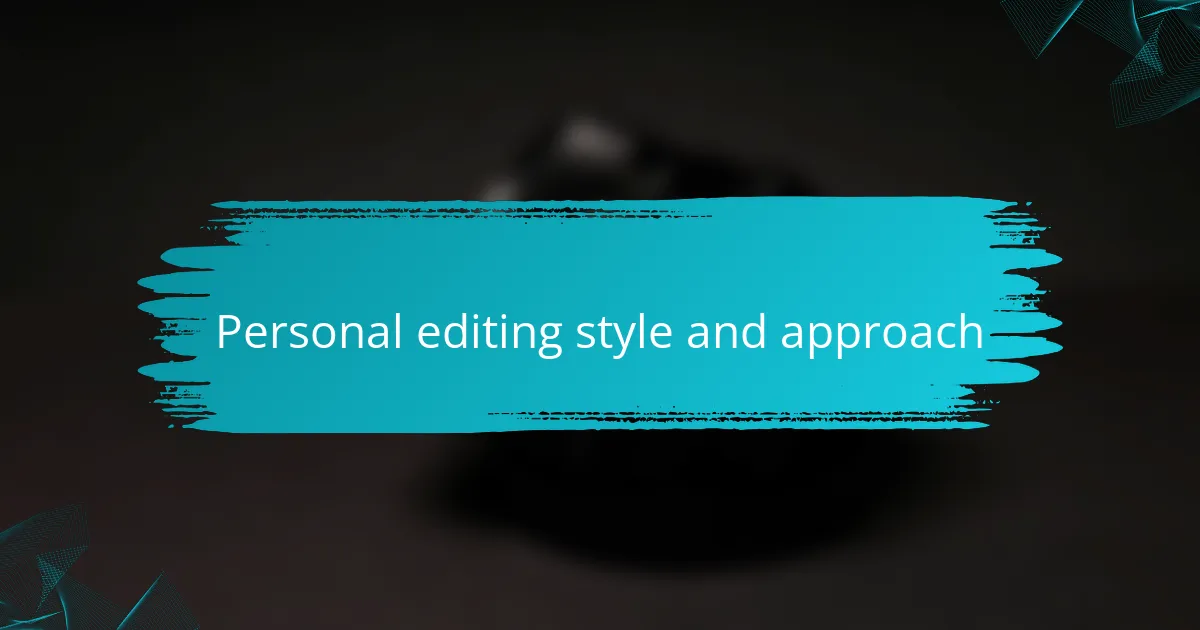
Personal editing style and approach
When it comes to my personal editing style, I strive for a balance that showcases the beauty of the moment while retaining a natural appearance. I believe each couple has a unique story, and my editing process reflects that. For instance, during a recent wedding, I emphasized the soft glow of sunset light in a couple’s first dance, which added a romantic feel while ensuring the colors remained true to life.
I typically lean towards a light and airy aesthetic, enhanced by subtle adjustments to contrast and brightness. However, I also enjoy playing with textures and tones to evoke specific emotions—like the warmth of a cozy indoor ceremony or the vibrant energy of an outdoor celebration. It’s all about creating a visual narrative that resonates with both the couple and their families.
Here’s a comparison of my typical editing approaches:
| Editing Style | Description |
|---|---|
| Light and Airy | Bright, soft highlights with a focus on pastel colors. |
| Rich and Warm | Warm tones with deeper shadows to create a cozy atmosphere. |
| Vibrant and Bold | High contrast with lively colors for an energetic feel. |
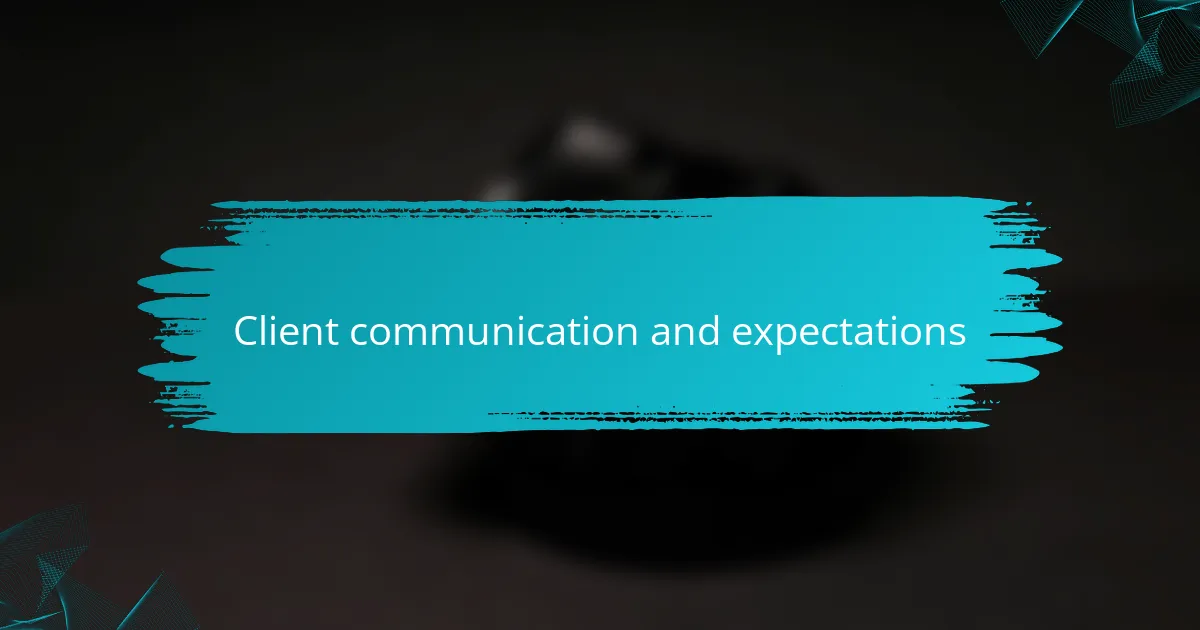
Client communication and expectations
Effective communication with clients is crucial in wedding photography. I remember a time when a couple had specific requests about color grading and image styles. By discussing their visions and expectations upfront, I felt more confident tailoring my edits to reflect their unique personalities, ultimately leading to happy clients.
To ensure everyone is on the same page, I recommend focusing on the following:
- Initial Consultation: Discuss styles and preferences during the first meeting.
- Reference Images: Share examples of past work to clarify expectations.
- Regular Updates: Keep clients informed about progress and any adjustments.
- Feedback Loop: Encourage clients to share their thoughts on edits, allowing for collaborative changes.
- Final Review: Schedule a meeting or call to go through the final edits before delivery.
